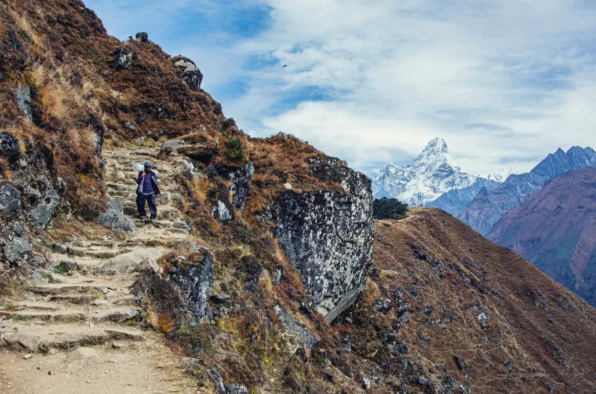The Everest Base Camp Trek is one of the most iconic and sought-after adventures in the world, offering an unforgettable journey to the foothills of Mount Everest (8,848.86 m) — the highest peak on Earth. Every year, thousands of trekkers from across the globe set out on this life-changing journey, drawn by the breathtaking Himalayan landscapes, rich Sherpa culture, and the dream of standing face-to-face with the mighty Everest.
More than just a trek, the Everest Base Camp (EBC) adventure is a personal pilgrimage — a challenge of endurance, spirit, and awe for nature’s greatest masterpiece.
Overview of the Everest Base Camp Trek
Located in the Khumbu region of Nepal, the trek begins with a thrilling flight from Kathmandu to Lukla (2,840 m) — one of the most scenic and adventurous airstrips in the world. From there, the trail winds through lush valleys, alpine forests, glacial moraines, and high-altitude passes, leading trekkers to the historic Everest Base Camp (5,364 m).
The route is part of the Sagarmatha National Park, a UNESCO World Heritage Site, home to rare flora, fauna, and vibrant Sherpa villages. With each step, the landscape transforms dramatically — from green hills and rhododendron forests to rugged terrain surrounded by snow-covered peaks.
Highlights of the Everest Base Camp Trek
- Stand at the base of Mount Everest, the world’s tallest mountain.
- Panoramic sunrise view of Everest, Lhotse, Nuptse, and Ama Dablam from Kala Patthar (5,545 m).
- Explore Namche Bazaar, the cultural and economic hub of the Khumbu region.
- Visit ancient Tengboche Monastery, the spiritual heart of the Sherpa community.
- Experience the warm hospitality of the Sherpa people and learn about their mountain traditions.
- Trek through Sagarmatha National Park, home to musk deer, Himalayan tahr, and rare birds.
The Route: Step-by-Step Journey to the Base Camp
Day 1: Kathmandu to Lukla, Trek to Phakding (2,610 m)
The adventure begins with a short but scenic flight to Lukla, followed by a gentle hike along the Dudh Koshi River to reach Phakding. The first day allows trekkers to acclimatize gradually.
Day 2: Phakding to Namche Bazaar (3,440 m)
Crossing suspension bridges and dense pine forests, trekkers reach the bustling Sherpa town of Namche Bazaar, known for its cafes, bakeries, and mountain gear shops. It’s the gateway to Everest and a hub for acclimatization.
Day 3: Acclimatization Day in Namche Bazaar
A rest day helps the body adjust to the altitude. Trekkers can hike to Everest View Hotel or visit the Sherpa Museum, enjoying the first glimpse of Everest and Ama Dablam.
Day 4: Namche to Tengboche (3,867 m)
The trail ascends through rhododendron forests to Tengboche, home to the famous Tengboche Monastery, with Everest and Ama Dablam forming a magnificent backdrop.
Day 5: Tengboche to Dingboche (4,410 m)
Descend to Debuche and cross the Imja Khola River before climbing toward Pangboche and Dingboche — a beautiful village surrounded by towering peaks.
Day 6: Acclimatization in Dingboche
Spend another day adjusting to the thin air. Short hikes to Nangkartshang Hill offer breathtaking views of Makalu, Lhotse, and Island Peak.
Day 7: Dingboche to Lobuche (4,910 m)
The trail becomes steeper as trekkers pass Thukla Pass and the memorial park dedicated to climbers who lost their lives on Everest. The night is spent at Lobuche.
Day 8: Lobuche to Everest Base Camp (5,364 m), Overnight at Gorak Shep (5,164 m)
This is the most rewarding day — after several hours of trekking through glacial terrain, trekkers finally reach Everest Base Camp Trek. Standing at the base of the world’s tallest mountain is an unforgettable moment filled with pride and emotion.
Day 9: Hike to Kala Patthar (5,545 m), Return to Pheriche (4,240 m)
Early morning climb to Kala Patthar, one of the best viewpoints in the Himalayas. Watch the sunrise illuminate Everest’s peak before descending back to Pheriche.
Days 10–12: Return Journey to Lukla
Follow the same trail through Tengboche, Namche, and Phakding before returning to Lukla for the flight back to Kathmandu.
Best Time for the Everest Base Camp Trek
The best seasons for the Everest Base Camp Trek are spring (March–May) and autumn (September–November).
- Spring: Clear skies, moderate temperatures, and blooming rhododendrons make this a favorite season.
- Autumn: Stable weather and crystal-clear mountain views attract trekkers worldwide.
- Winter (December–February): Cold but peaceful, ideal for those seeking solitude.
- Monsoon (June–August): Fewer trekkers, but trails can be slippery and visibility limited due to rain.
Accommodation and Meals
Accommodation along the trail consists of teahouses, simple but cozy lodges run by Sherpa families. Rooms typically include twin beds, warm blankets, and shared bathrooms.
Meals feature a mix of Nepali, Tibetan, and Western dishes — dal bhat (lentils and rice), noodles, pancakes, soups, and momos (dumplings). Trekkers are encouraged to eat plenty of carbohydrates and stay hydrated to maintain energy at high altitudes.
Culture and People
The Sherpa people, famous for their mountaineering skills and resilience, are the heart of the Everest region. Visiting monasteries, mani walls, and prayer flags along the route gives trekkers a deep insight into Buddhist culture and traditions.
At Tengboche Monastery, one can witness monks performing daily rituals against the backdrop of towering peaks — a spiritual experience that defines the trek’s cultural richness.
Altitude and Safety
The trek reaches elevations above 5,000 meters, making altitude sickness (AMS) a key concern. Gradual ascent and acclimatization days in Namche and Dingboche are essential.
Tips for safe trekking:
- Ascend slowly and rest when needed.
- Stay hydrated (3–4 liters of water daily).
- Avoid alcohol and smoking.
- Carry Diamox (Acetazolamide) after consulting a doctor.
Most trekkers complete the journey safely with proper preparation and guidance from experienced guides.
Permits Required
To trek to Everest Base Camp, you’ll need:
- Sagarmatha National Park Entry Permit – Available in Kathmandu or Monjo.
- Khumbu Pasang Lhamu Rural Municipality Permit – Obtainable in Lukla.
Both permits help fund local conservation and development projects.
Packing List
For comfort and safety, bring:
- Down jacket and warm layers
- Trekking boots and extra socks
- Gloves, hat, and sunglasses
- Sleeping bag (-10°C recommended)
- Water purification tablets or filter
- Sunscreen, lip balm, and personal medicines
- Headlamp and power bank
Pack light but ensure essentials for high-altitude trekking.
Why Choose the Everest Base Camp Trek?
The Everest Base Camp Trek is more than a physical challenge — it’s a journey of self-discovery. Standing before the world’s tallest peak inspires a profound sense of accomplishment and connection with nature.
Unlike commercialized destinations, this trek offers raw beauty, friendly locals, and a feeling of freedom that only the Himalayas can provide. From the moment you step onto the trail to the final view from Kala Patthar, every moment feels unforgettable.
Conclusion
The Everest Base Camp Trek is truly a once-in-a-lifetime adventure. It combines natural grandeur, cultural depth, and the thrill of trekking through one of the world’s most famous landscapes.
Whether you’re a first-time trekker or an experienced adventurer, EBC offers an experience that challenges your body, enriches your mind, and lifts your spirit. As you gaze at Mount Everest glowing under the Himalayan sun, you’ll realize that the journey itself — not just the destination — is what makes the Everest Base Camp Trek so extraordinary.

